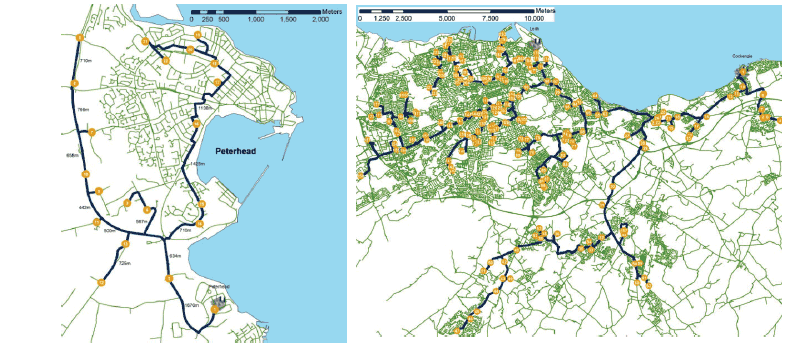The recovery of heat from power generation in Scotland: study
This study examines the technical and financial prospects for recovery of heat from four sites used for large scale fossil fuel power generation and then explores policies that could help make the recovery of heat a more practical option.
12 Conclusions
12.1 Technical
The technical assessment shows that it is possible to develop extensive networks for all four sites, with a range of configurations. The network for Peterhead would only serve very local customers, as the area beyond Peterhead is very rural with limited potential for heat supply. The network for Cockenzie is much bigger, extending well into Edinburgh as this area is urban with many potential heat consumers.

The technical assessment shows that it is possible to recover significant amounts of heat from future power stations that have CCS fitted. This is a key issue because CCS uses a significant amount of heat. CCGT stations are more at risk of this because the heat is extracted from the steam turbine. Hence CCGT sites that could serve an extensive network of heat consumers are most sensitive to this issue. In Scotland this is most evident for the Cockenzie site.
12.2 Financial
The analysis uses a number of different assumptions on the percentage of sites captured as heat customers and the timescale to build up the heat network and heat sales. Some key results are:
- If all 100% of heat loads (existing and future buildings) connect within 15 years none of these district heating systems would be financially viable (9% IRR). This is not a surprising outcome - if the returns were attractive projects would be under development.
- The funding gap to make projects viable is significant - from £12 million to £92 million.
- If a more accelerated connection rate is assumed the IRR improves significantly and the funding gaps reduce. This scenario is currently unrealistic for Scotland however it is close to the situation in Denmark where heat planning laws require existing and new buildings to connect to the heat suppliers network.
The sensitivity tests show that revenue incentives would be an expensive and impractical route to support schemes. However accelerating the connection of heat loads offers a route towards more cost effective schemes.
12.3 Planning
The review of current and future planning policy concludes that:
- Many of current planning policies support heat and co-location of heat supply and demand.
- NFP2 and SPP are recent documents, and the strategic and local development plans are not yet in place, so it is too early to be fully certain of the impact of these policies.
- It is likely that there will be some progress, as developers and planners use the new policies.
- However, the policies were not drafted to deliver a rapid transformation in the uptake of heat recovery and district heating in Scotland. So these new policies are not expected to create a market for district heating as found in countries like Denmark.
Assuming that these conclusions are correct, and that there is a policy requirement to deliver much great uptake of heat recovery and district heating, this suggests that:
- In the short term opportunities for heat recovery and district heating may be missed, as co-location cannot be delivered retrospectively.
- If a transformation in the uptake of heat recovery and district heating is required, further changes in planning policy will be required to accelerate uptake.
- This may require more prescriptive policies, so a review of international planning policies would provide valuable insight into the policy options that have been used and how they could be relevant to the Scottish context.
12.4 Policy Options
The model was used to test a selection of policy ideas. The analysis shows that:
- Most policy ideas have a modest impact on the IRR, none of the policies and their assumed impacts led to an increase of IRR to 9%.
- The two policy ideas which had the highest impact both co-locate heat supply and heat demand.
These results demonstrate that planning policies are likely to be the most effective way to encourage heat recovery and district heating.
12.5 Overall Conclusions
This study shows that it is technically possible to recovery significant amounts of heat from the four large power station sites. However the financial returns are far from attractive for investors.
Direct financial support from the public sector for these investments would need to be very significant to have any impact on IRR and would be very difficult to justify, due to the source of the heat (fossil power stations) and the State Aid requirements.
A range of other policy ideas were tested, these had relatively limited impact on the IRR, but policy ideas that reduced investment costs by co-location of heat supply and demand had the highest impact.
Hence there could be the potential to develop planning policies with mandatory requirements for co-location, drawing on international experience to shape these policies to the Scottish contents and opportunity.
12.6 Broader Recommendations
The study also includes a number of broader recommendations, recognising that there is a wider range of opportunities for district heating in Scotland beyond heat recovery from the four power station sites, these recommendations cover:
- Investigation of the wider potential for district heating in Scotland;
- Comparison of district heating with the competing options for low carbon heat;
- A review of international best practice in policies for district heating;
- The potential for a Heat Planning Law in Scotland;
- Heat Mapping;
- District heating Code of Practice;
- Examining the role of regulation in the expansion of district heating;
- How EU Energy Efficiency Action Plans could support policy development; and
- Integration of district heating into existing policy and programmes.
These recommendations could be taken up by the proposed Expert Commission on District Heating.
There is a problem
Thanks for your feedback